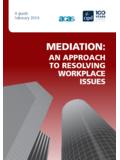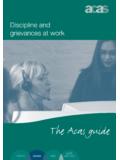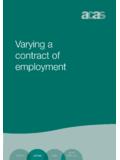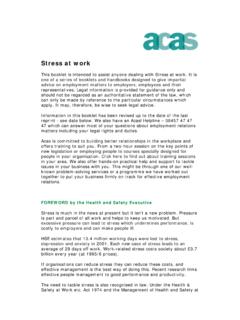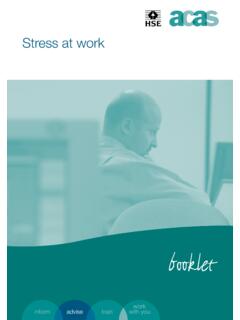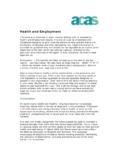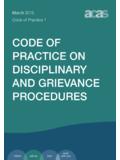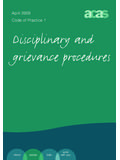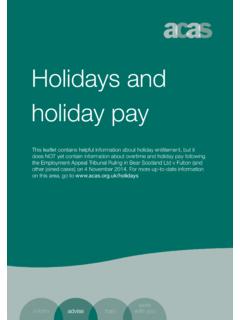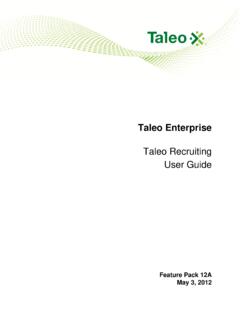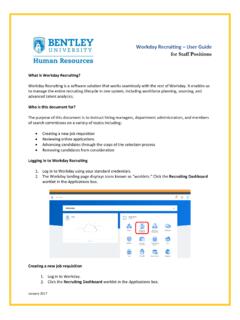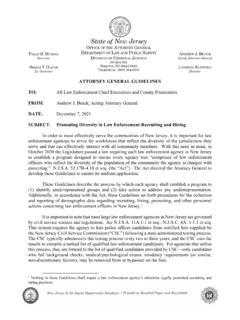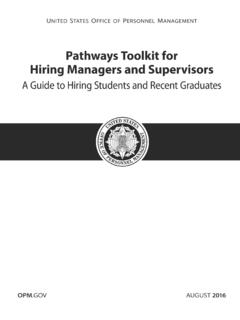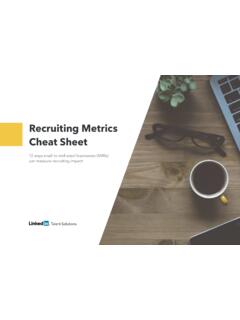Transcription of Recruiting Staff Guide - Acas
1 Guidance Recruiting Staff January 2019 Recruiting Staff 2 About Acas What we do Acas provides information, advice, training, conciliation and other services for employers and employees to help prevent or resolve workplace problems. Go to for more details. Must and should Throughout the Guide , a legal requirement is indicated by the word must for example, a Written Statement of Terms and Conditions of Employment must The word should indicates what Acas considers to be good employment practice. January 2019 Information in this Guide has been revised up to the date of publishing. For more information, go to the Acas website at Legal information is provided for guidance only and should not be regarded as an authoritative statement of the law, which can only be made by reference to the particular circumstances which apply. It may, therefore, be wise to seek legal advice. Recruiting Staff 3 Contents About this Guide .
2 4 Recruiting Staff .. 4 At-a-glance chart .. 5 Step 1: hiring options .. 6 Step 2: Essential documents .. 7 Job description .. 8 Person specification .. 9 Job application form .. 10 Equality and diversity monitoring form .. 10 Information about the employer .. 11 Job offer 11 Step 3: Advertising a job .. 13 Considerations before advertising .. 13 Writing the 14 Where to advertise .. 15 Step 4: Sifting and selecting .. 17 Interviews .. 17 Practical tests .. 19 Assessment centres .. 20 Health checks .. 21 Selecting the best candidate for the job .. 22 Step 5: Completing final details .. 23 Pre-employment checks and offering the job .. 23 Handling pay queries .. 24 References .. 24 Proof of qualifications .. 26 Contract queries .. 26 Other considerations .. 27 General Data Protection Regulation and recruitment .. 27 Recruiting without discriminating .. 28 Reasonable adjustments for disabled job applicants .. 29 The right to work in the UK .. 29 Criminal records.
3 30 Reviewing if recruitment was effective .. 31 Further information .. 31 Recruiting Staff 4 About this Guide Most employers fully appreciate that the success of an organisation can hinge on its Staff . But, finding and keeping the right number of employees with the necessary abilities and attitudes requires skills which can sometimes be undervalued, overlooked or simply rushed. This Guide goes through the stages of hiring a new employee up until their first day. Please see the companion Acas Guide , Starting a new employee: the induction, on settling them in so they become effective as soon as possible and want to stay. This Guide is aimed at employers looking to handle recruitment themselves - whether they are the owner of a small firm, the head of a department in a larger organisation, part of a human resources team, or a line manager/supervisor. It will also help no matter if the involvement is in some or all of the recruitment process. Job applicants may also find the Guide useful in understanding the employer s perspective.
4 Recruiting Staff The aim of recruitment is to get the best person for the job and consistently fill vacancies that way. The importance of effective and fair recruitment should not be under-estimated. Appointing people unsuited to a vacancy can be costly and mean: managers and supervisors will often have to invest additional time in training and supporting such a recruit when they could otherwise use the time and effort on other business where training or other support cannot help, there is a strong risk the new recruit will leave (or be dismissed from) the role. This will be demoralising for the employee concerned and can also upset the morale of the team they leave behind another recruitment process to fill the vacancy. On the other hand, securing the best and most suitable recruit should bring benefits to the individual, their team, managers and the business as a whole. Recruiting Staff 5 At-a-glance chart STEP 1: hiring options Work out what is really needed more Staff , new skills, specific duties Make sure the employment terms and conditions on offer are attractive in the current labour market Don t forget the benefits of training and developing current Staff STEP 2: Essential documents Consider factors, such as has the role changed or is it a completely new role, before preparing the documents The six documents: 1.
5 Job description 2. Person specification 3. J ob application form 4. Equality and diversity monitoring form 5. Information about the employer 6. Job offer letter template STEP 3: Advertise the job Consider the range of media and advertise opportunities in at least two channels Make important decisions, such as how the successful candidate will be picked, before compiling the job ad Compile the ad, including asking applicants to say if they need any reasonable adjustments for any part of the recruitment process STEP 4: Sift and select Check again if applicants need any reasonable adjustments Make reasonable adjustments if the candidate is disabled At least two people should sift applications to select candidates for interviews etc Prepare for the interview/ tests/ assessment centre Conduct the interview/ tests/ assessment centre and score candidates Select the best candidate for the job Recruiting Staff 6 STEP 5: Complete final details Offer the job and make necessary pre-employment checks Resolve any queries over the contract of employment and the checks File documentation candidate s written acceptance of the job offer Start to prepare for the new recruit s arrival Step 1: hiring options There is far more to an employer working out how many Staff it needs and what it needs them for than might at first appear to be the case.
6 In less considered situations, recruitment might simply amount to trying to plug gaps when they appear. The more proactive employer might consider a range of factors in determining current staffing needs and anticipating what they may be in the future. An employer should consider: the needs of the business: Consider if there will be enough work for new recruits for example, can workloads be seasonal? Also, how can a temporary decline in productivity be avoided while new recruit/s are brought up to speed? In addition, check that the recruitment process will give a reasonable amount of time to both hire and settle in new recruits changes in the labour market: This includes monitoring the availability of appropriately-skilled candidates in the desired location, on the terms and conditions on offer, as well as what competing organisations are looking for and offering developing new and existing Staff : Organisations will usually benefit in a variety of ways including in recruitment - by developing the capabilities of new and existing Staff .
7 Coaching and training will better equip them for promotion, particularly where there may otherwise be a shortage of candidates. They are more likely to buy into this enthusiastically if they are consulted individually and/or through recognised representation such as a recognised trade union are more Staff needed?: P inpoint why and where extra Staff are needed, and how many are new skills needed?: Pinpoint why and where new skills might be needed sometimes an organisation needs more than just a higher headcount. Also establish if there is any need for specialist skills or knowledge and if the organisation can acquire these through Staff development, Recruiting new and already-skilled Staff , or a blend of these options? Recruiting Staff 7 competitors pay and benefits packages: Knowing what rivals are offering to attract recruits is important and is rarely just about pay. Benefits such as training, career development, flexible hours, part-time work/jobshares and working from home can be factors, too presenting a people and family friendly image: Having and/or developing such a reputation can be an advantage in attracting good applicants.
8 This might involve offering increased flexibility or perks such as childcare vouchers and health plans holding exit interviews: Talking to departing Staff , their colleagues and manager may give an insight into a consideration or requirement of which the recruiter may be unaware. They may also generate good ideas for useful changes, as well as giving the organisation a better understanding of why Staff leave and if any steps might be taken to retain them Recruiting an adaptable workforce: Recruiting Staff who are multi-skilled, open to change, and demonstrate an enthusiasm for training and development can help an employer deal more efficiently with organisational changes business practicalities: Check the organisation has the premises, equipment, technology and resources to accommodate and develop new recruits as well as existing Staff will recruitment be handled in-house, or using an agency? In some circumstances, especially where there is a need for particularly fast recruitment, a recruitment agency may be preferable to an employer Recruiting Staff directly.
9 Recruitment agencies which are members of a trade association are subject to a code of practice and can provide effective recruitment. Step 2: Essential documents The key task here is for an employer to get ready all the necessary documents for a smooth recruitment process. It s also important to determine if and how a job may need to change from the role held by the last post-holder. Or, if it s a completely new role, it s important to finalise the requirements. Recruiting Staff 8 What are the essential documents? Employers will usually need to provide the following documents as a bundle to a job applicant: 1. Job description 2. Person specification 3. Job application form 4. Equality and diversity monitoring form 5. Information about the employer Applicants should be provided with a covering note that makes it clear if the successful candidate will need any health checks or references. The successful candidate will also require a Job offer letter. Before preparing the documents, an employer should consider: key tasks, skills, attributes, behaviours, values, knowledge and experience required for the role: Have the aims of the role changed?
10 Is new technology being introduced? Will the new jobholder require additional skills? Also, does the company have new products which need to be taken into consideration? work flow: Is it fairly constant or seasonal? Has it altered? Could staggered hours or overtime help with any peaks, troughs or changes? Details such as hours and times of work would need to be included in writing in the new employee s terms and conditions of employment flexibility: Being open to requests from candidates for flexible working can open up a vacancy to people with the skills the organisation seeks and who otherwise might not be able to consider the vacancy. The request may meet the organisation s business needs. However, circumstances may suit keeping the role as performed by the last jobholder, and offering the same terms and conditions. Job description Also known as a job specification, it should make clear the job main purpose: Try to do this in one sentence. For example, To increase revenue from advertising on the company s website by 25% main tasks: Be precise.
